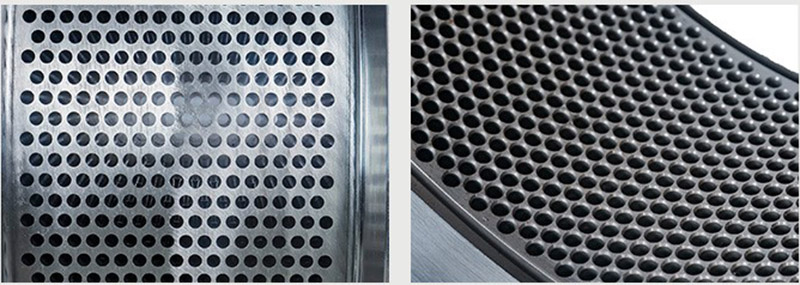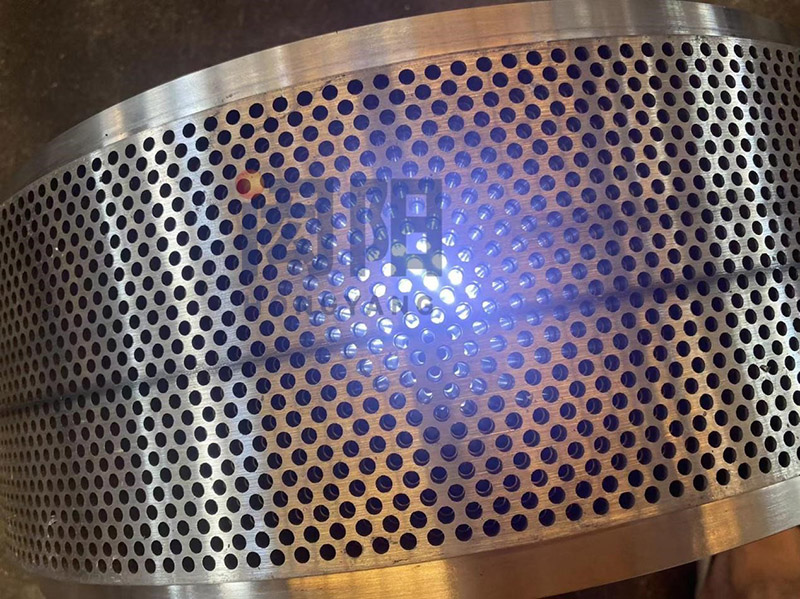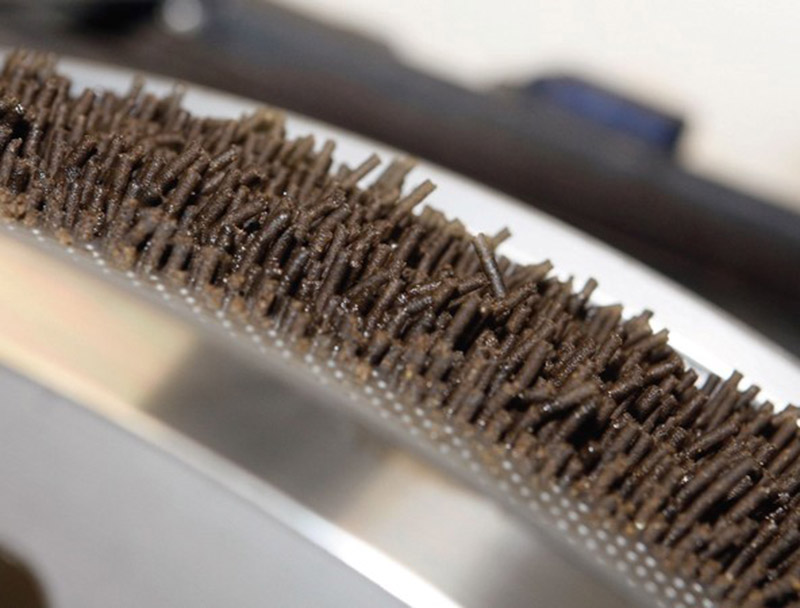As a customer of Hongyang Feed Machinery, we have compiled the key points for daily use and maintenance of the ring mold for you.
1.Use of new ring dies
The new ring die must be equipped with a new roller shell: the correct use of the pressure roller is one of the most critical factors affecting the use of the ring die. In our long-term production and service, we have found that many ring dies have uneven working surfaces, low hole yield, reduced production capacity, and new ring dies cannot produce materials. Most of the reasons are due to non-standard use of pressing.
The characteristic of the new ring die is that the working surface is flat, but the smoothness of the eye holes and the guide port do not meet the normal requirements for granulation. The eye holes of the new ring die have a relatively high resistance and friction force on the material (especially for small aperture ring dies), while the old shell is severely worn at both ends, and the material is prone to sliding into the pressure reducing groove from the worn parts of the roller shell, resulting in poor or no discharge from the eye holes on both sides of the new ring die. Therefore, it is required that the new ring die must be equipped with a new roller shell for use. Ensure that the supporting use lasts for more than 100 hours, and ensure that the working surface of the new ring die is evenly compressed, and that the eye hole yield and polishing rate meet the requirements. Only then can the best performance of the ring die be achieved. The principle of using pressure rollers for ring dies is that each ring die must be equipped with a separate set of pressure rollers at the beginning of use, and the same set of roller shells cannot be used with other ring dies in series.
2.New ring die ground grinding
Before leaving the factory, the die hole of the ring die has been polished with a cutter, but its micro level has not yet reached the mirror surface smoothness standard. In addition, there are special substances left during heat treatment, such as oxide layers. Therefore, when using it, the die hole should be ground with powder oil and fine sand.
Take the powder (oily rice bran is the best) to indicate the moisture content. Add about 4% water, and then add an appropriate amount of oil to stir evenly. Grab the material into a ball by hand, and it is easy to disperse easily (slightly wetter than steam quenched materials in normal production). First, rinse the ring die with the mixed materials for about three minutes. When the porosity is observed to be above 98%, fine sand can be added for flushing and grinding. The total amount of fine sand added is one-fifth or one-fourth of the oil material, and it should be added 4-5 times or more. Every time fine sand is added, it is necessary to observe the changes in the host current. The current should not exceed 70% of the standard current. Only when the normal discharge current is stable can fine sand be added. Observe the discharge situation. If the material is not very dry and there is smoke, it should be caused by the high temperature of the material. Allow the material to cool down before flushing. If the material becomes very dry and the vibration of the pellet machine increases significantly during flushing, some grease should be added appropriately to prevent the die hole from blocking or the safety pin of the pellet machine from breaking. Add fine sand and grind for 20-30 minutes, then use oil to extrude the material containing fine sand from the die hole, allowing the oil to fill the die hole. Check that the hole rate is above 98% and clean the machine. Due to the easy enlargement of the gap between the pressure rollers during the flushing process of the ring die, in order to ensure smooth production after starting and feeding, it is also necessary to check and adjust the gap between the pressure rollers once.
3.Blocking ring die treatment:
① Feed is blocked in the die hole. If it is a large aperture (D2.5mm or above), it can be drilled through with a drill bit or punched out with a cement steel nail. Note that the drill bit or steel nail used should be less than 0.2mm of the effective hole;
② If the pore size of the blocked ring die is less than D2.5mm, it is difficult to break through with a pistol drill or steel nail, and the drill bit or steel nail is blocked in the die hole and cannot be taken out: the ring die can be boiled in oil, oil or animal or vegetable oil can be used, and the oil can be heated at high temperature to produce carbonization of the feed in the die hole, which is conducive to extrusion. Operation method: Place the ring die into an iron bucket, add engine oil or animal and vegetable oil, and the oil surface should submerge the ring die. The oil bucket should be 0.5 m higher than the oil surface (preferably with a cover) to prevent oil from overflowing after heating up, causing accidents. After everything is ready, heat it over a small fire and control the temperature for 6-10 hours after boiling. High protein feed takes 8-10 hours;
③ Do not take it out immediately after cooking, as the temperature of the ring die is high at this time, which will dry and harden the feed in the die hole, which is not conducive to extrusion. It should be cooled together with oil for about two hours, then taken out and installed, and then the particle material mixed with oil should be used to rinse the ring die. At the beginning of flushing, a small amount of material should be fed, and the discharge situation, current of the pellet machine, and machine vibration should be observed. The feeding should not be too fast to prevent the ring die from cracking due to excessive pressure or the safety pin of the pellet machine from breaking. Rinsing the ring die until the porosity reaches 98%.
Post time: Sep-18-2023















